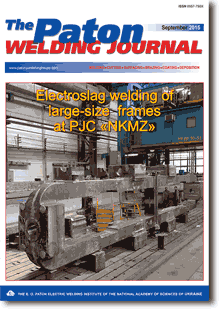| 2015 №09 (01) |
DOI of Article 10.15407/tpwj2015.09.02 |
2015 №09 (03) |

The Paton Welding Journal, 2015, #9, 13-19 pages
Diffusion welding of steel to tin bronze through porous interlayers of nickel and copper
A.I. Ustinov, Yu.V. Falchenko, T.V. Melnichenko, L.V. Petrushinets, K.V. Lyapina, A.E. Shishkin And V.P. Gurienko
E.O. Paton Electric Welding Institute, NASU. 11 Bozhenko Str., 03680, Kiev, Ukraine. E-mail: office@paton.kiev.ua
Abstract
Friction assemblies based on steel and bronze are widely applied in many mechanical systems. Steel and bronze joints are produced by diffusion welding at temperatures of 750-850 °C. Defect formation in the joint zone in a number of cases is associated with high welding temperature. The paper deals with the possibility of lowering diffusion welding temperature by interlayer application in the case of making permanent joints of steel (20Kh3MVF) and bronze (BrOSN 10-2-3). Porous nickel and copper foils, produced by vacuum deposition, were used as interlayers. It is shown that application of such porous interlayers allows welding temperature to be lowered to 660-700 °C. Lowering of welding temperature prevents growth of liquation precipitates of tin and lead in the joint zone, that lowers the probability of defect formation. The thus produced joints are stable at short-time heating to 800-850 °C, that allows later on performing heat treatment of steel as part of composite material to increase its strength properties. 13 Ref., 1 Table, 5 Figures.
Keywords: bimetal joints, steel, bronze, porous interlayers, diffusion welding, welding modes, joint structure
Received: 30.04.15
Published: 26.10.15
References
- Kazakov, N.F. (1976) Diffusion welding of materials. Moscow: Metallurgiya.
- Malevsky, Yu.B., Nesmikh, V.S. (1981) Pressure welding of bronze with steel. Moscow: Metallurgiya.
- Potekhin, B.A., Izmajlov, D.K. (2008) Peculiarities of vacuum diffusion welding without application of external pressure. Svarochn. Proizvodstvo, 2, 8-13.
- Kazakov, N.F. (1981) Diffusion welding of materials: Refer. Book. Moscow: Mashinostroenie.
- Charukhina, K.E., Golovanenko, S.A., Masterov, V.E. et al. (1970) Bimetallic joints. Moscow: Metallurgiya.
- Ustinov, A., Falchenko, Y., Melnichenko, T. et al. (2013) Diffusion welding of aluminium alloy strengthened by Al2O3 particles through an Al/Cu multilayer foil. J. Materials Proc. Techn., 213(4), 543-552. https://doi.org/10.1016/j.jmatprotec.2012.11.012
- Lyushinsky, A.V. (2011) Application of nanopowders of metals in diffusion welding of dissimilar materials. The Paton Welding J., 5, 31-34.
- Kharchenko, G.K., Ustinov, A.I., Falchenko, Yu.V. et al. (2011) Diffusion bonding of g-TiAl base alloy in vacuum by using nanolayered interlayers. Ibid., 3, 2-6.
- Ustinov, A.I., Lyapina, K.V., Melnichenko, T.V. (2005) Regularities of stainless steel porous structure formation during its deposition from vapor phase in presence of sodium chloride vapors. Advances in Electrometallurgy, 4, 19-24.
- Ustinov, A.I., Matvienko, Ya.I., Polishchuk, S.S. et al. (2009) Investigation of phase transformations and plastic deformation at continuous heating of Al/Cu multilayer foil. The Paton Welding J., 10, 23-27.
- Vajvod, N.I., Bykov, G.M. (1982) Diffusion welding in production of cylinder blocks of axial-plunger pumps. Svarochn. Proizvodstvo, 3, 32-33.
- Ustinov, A.I., Falchenko, Yu.V., Melnichenko, T.V. et al. (2015) Vacuum diffusion welding of stainless steel through porous nickel interlayers. The Paton Welding J., 7, 3-9. https://doi.org/10.15407/tpwj2015.07.01
- Kuznetsova, R.I., Bryukhovetsky, V.V., Pojda, V.P. (1995) Mechanisms of development of grain-boundary pores and local deformation heterogeneity under conditions of superplastic flow. Metallofizika i Nov. Tekhnologii, 17(8), 64-72.
